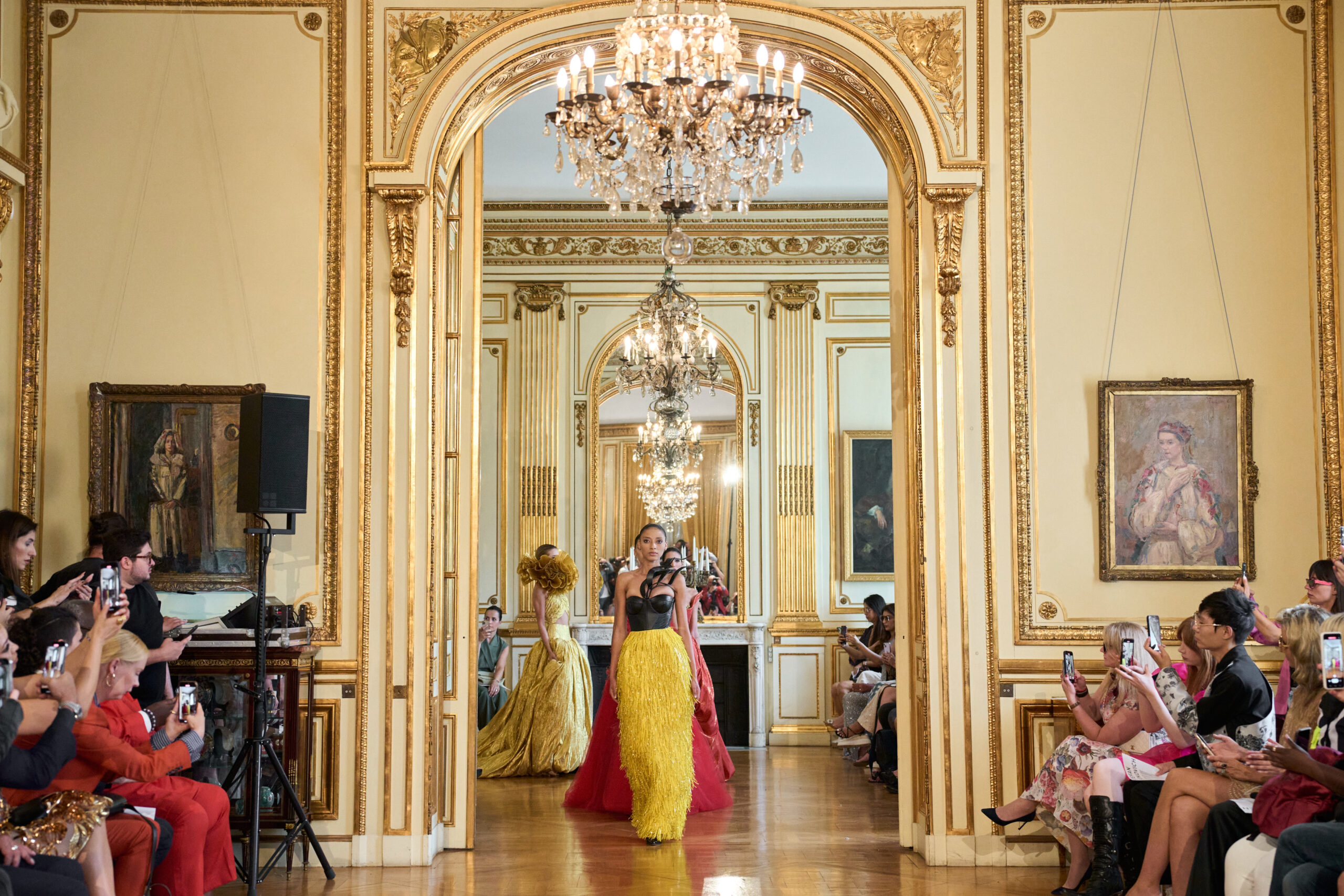défilés de modeEVENEMENTS A PARISEventsMode
Défilé PATRICK PHAM

Paris Haute Couture Fashion Week
Collection couture automne hiver 2019 2020 – Couture Show – FALL WINTER 2019 – 2020
La Perle de l’Extrême-Orient
Que ce soit dans « Indochine » ou « L’Amant », « Vien Dong » a toujours été dans le cœur des Français. Cet amour est à la source de l’inspiration de Patrick Pham. En voyageant dans les villages, redécouvrant des tissages, des souvenirs lointains remontent. Les bagages qu’a ramenés le créateur sont des chefs-d’œuvre pleins d’ivoire d’artisans originaires d’un pays lui-aussi profondément amoureux de la France. Le vieux sentiment français pour l’Extrême-Orient renaît avec une autre histoire d’amour. Paris, c’est comme rencontrer un vieil ami !
Patrick Pham présente 29 robes cousues main à partir de matières réputées fabriquées dans les villages du Vietnam, ainsi que des accessoires confectionnés à la main par des artisans de Hue, la ville impériale de la dynastie Nguyen du Vietnam.
« Lanh My A » est un tissage de la soie, teint à partir du fruit de Diospyros Mollis, connu localement sous le nom de « mặc nưa ». Lanh My A a été utilisé pour le costume des familles royales du Cambodge, du Laos et de la Thaïlande, ou comme cadeau de choix pour les riches familles, les propriétaires terriens et les classes aisées indo-chinoises. Dans les mains de Patrick Pham, Lanh My A se transforme en élégance pour des costumes de luxe et des robes de soirée. La beauté de Lanh My A débute avec le grand soin porté au cocon de ver à soie, de sorte que chaque ver à soie puisse extraire les fils les plus sains et les plus nobles. La soie tissée est soumise à une technique de teinture tout à fait unique qui prend près de 5 mois. Le tissu doit subir 2 cycles de teinture et un séchage au soleil et au vent. C’est le savoir-faire secret de la soie noire Lanh My A, semblable à du cuir, qui malheureusement risque de se perdre. De nos jours, de nombreux habitants se tournent vers des tissus plus conventionnels et industriels pour des raisons mercantiles. Il n’existe plus qu’une poignée d’artisans dans tout le pays qui tentent de raviver ce secret naturel.
Il était une fois dans l’histoire du Vietnam une belle tisserande qui avait été choisie pour se marier avec le prince et devenir la reine. On l’appelait Queen Y Lan. Queen Y Lan est l’une des reines les plus célèbres et les plus aimées pour l’amour qu’elle portait à son peuple. Elle est honorée comme l’ancêtre fondatrice du tissage de la soie en enseignant à son peuple à planter des mûriers, à élever le ver à soie et à la tisser. Selon la tradition, chaque fille vietnamienne grandit en sachant tisser, broder et coudre. Les tissus semblent hériter de leur personnalité et de leur destinée qui semble tissée de leurs mains d’ivoire. Le tissu et la soie sont en effet le reflet culturel d’une nation multi-ethnique.
Le brocart est un produit unique que les minorités ethniques du Vietnam transmettent de génération en génération et chacun caractérise leur culture. Le brocart est un tissu de coton, de lin ou de chanvre, fabriqué à la main. Les tissus sont teints à partir de plantes sauvages avec une variété de couleurs : de la plus sombre à la plus brillante. Le tissu comporte des motifs qui représentent chaque groupe ethnique de manière unique. Ces motifs sont gravés au cours du processus de tissage, bien que ceux-ci semblent avoir été brodés en premier.
Le brocart symbolise la vie locale : rustique, généreux et sauvage. Patrick Pham en a fait quelque chose d’audacieux en effaçant les frontières culturelles liées au brocart. Il le mélange à d’autres matériaux tels que la peau de cheval et la fourrure de bétail. Dans la main de Patrick, le brocart rappelle le rythme effréné d’une « Tzigane » et le look sexy d’une « Bohémienne ». C’est la réunion de deux univers : le brocard rustique et le romantisme de Paris.
Patrick Pham crée une robe de mariée avec des matériaux innovants : la soie de fleurs de jacinthe – douce et élégante. Les accessoires en bois de Lilias de Perse, un matériau bon marché pour la fabrication et la construction de statues qui soudainement devient un matériau de luxe pour la fabrication de chaussures ouvragées et colorées.
En nommant sa collection « La Perle de l’Extrême-Orient » qu’il a voulue respectueuse de l’environnement, Patrick Pham vient probablement de commencer son nouveau voyage : le voyage visant à promouvoir le style de vie parisien, mais cette fois-ci, il se trouve quelque part en dehors de la France !
Pearl of the Far East
Whether it is in Indochine or in L’Amant, “Vien Dong” has been in the heart of France as a love. That loves inspired Patrick Pham. On his trip to the rural weaving villages, the young designer suddenly reminisce the distant memories. The luggage he brought back is filled masterpieces from the ivory-like hands of artisans from a country that is deeply in love with France. The old French sentiment for the Far East rises up again with another love story. Paris is just like to meet its old friend!
Coming to this Paris Fashion Week 2019, Patrick Pham presents 29 Couture dresses from handmade textile materials of Vietnam’s most famous weaving villages, along with handmade accessories made by artisans from Hue – the Imperial city of the Nguyen Dynasty of Vietnam.
“Lanh My A” is a silk weaving product dyed from Diospyros Mollis fruit, locally known as “mặc nưa”. “Lanh My A” has been used for costume of the royal families of Cambodia, Laos, and Thailand, or as a luxury gift for only rich families, landlords, and Indo-Chinese wealthy class. In the hands of Patrick Pham, Lanh My A seems to have been a classy material for luxury suit and soiree dress. The beauty of Lanh My A is dominated right from the care of silkworm cocoon so that each silkworm can pull out the best and healthiest silk threads. Especially, the woven silk is under a very unique dyeing technique. The dyeing process takes nearly 5 months to complete. Fabric must go through 2 dyeing cycles and sun drying in the wind. This is the secret know-how of the black, leather-like Lanh My A silk. Sadly, it is in danger of being lost. Nowadays, many local people turn to weave other normal fabrics since industrial textiles with high capacity can generate better income. The whole country now has only one artisan family whose have been trying to rebuild and implement this natural secret.
Once upon a time in the history of Vietnam, there had been a beautiful weaver who was chosen to marry to the Prince and become the Queen. People called her Queen Y Lan. Queen Y Lan is one of the most famous and beloved queens with a caring heart for her people. She was honored as the founding ancestor of silk weaving for teaching her people to plant mulberry, raise silkworm, and weave silk. As the tradition goes, every Vietnamese girl grows up knowing how to weave cloth, embroider, and sew. Fabrics seem to inherit their personalities and destiny from those ivory-like hands. The fabric and silk is indeed a cultural reflection of a multi-ethnic nation.
Brocade is a unique product that ethnic minorities in Vietnam pass down from generation to generation in such a way to reflect the characteristics of their culture. Brocade is a fabric made of cotton, linen or hemp yarn, all handwork. Fabrics are dyed from wild plants with variety of colors: gloomy sometimes, brilliant sometimes. There are patterns on the fabric that uniquely represent each ethnic group. These patterns are embossed during the weaving process, though those appear to be embroidered at first.
Brocade carries in itself the vibe of local live: rustic, but generous and wild. Encountering those characteristics of brocade, Patrick Pham did a bold thing: erasing the cultural boundaries of wild, liberal brocade. Brocade is mixed with other materials such as horse skin and cattle fur. In the hand of Patrick, Brocade has raised the wild rhythm of a “Tziganes” girl and the sexy look of a “Bohémien” girl. Brocade gets itself out of being a local material to romantically reunite in Paris
Patrick Pham creates a wedding dress with new materials : silk from hyacinth flowers. Hyacinth flowers on wedding dress – gentle but elegant. Accessories from jackfruit wood, which is a cheap material for statue making and construction, suddenly became luxury material for fashionable and colorful handicraft boots.
Naming the collection “Pearl of Far East” for Couture dresses from handmade and environmentally friendly materials, Patrick Pham probably just started his new journey: the journey to promote Paris fashion lifestyle, but this time, it is somewhere outside of France!



